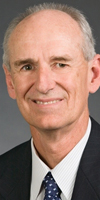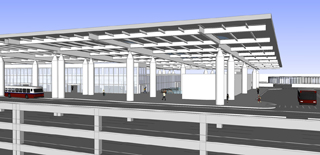|
Subscribe / Renew |
|
|
Contact Us |
|
| ► Subscribe to our Free Weekly Newsletter | |
| home | Welcome, sign in or click here to subscribe. | login |
Environment
| |
 |
April 19, 2012
Design drives rental car facility
Walker Parking Consultants

Wenner
|
Walker Parking Consultants has been involved in the planning, design and construction of the Consolidated Rental Car Facility (RCF) since performing an initial evaluation back in 1997.
In August 1998, Walker participated in a study led by CH2M Hill to define the scope, schedule and budget for a rental car facility. This effort included developing and studying various design concepts. These concepts explored various ways of accommodating the necessary functions of a consolidated rental car garage within the available site.
At the time that this work was being done, consolidated rental car facilities at airports, while growing in popularity with airport planners, were still a relatively new approach to addressing rental car accommodations. Rental car companies were accustomed to operating independent facilities at an airport, with little or no sharing of resources or equipment.
Not the least of the challenges in developing a consolidated facility was to configure the sharing of resources such as shuttle buses, fueling areas, customer counters, and wash/refueling areas in a way that would be acceptable to the rental car companies.
Competition among rental car companies for airport customers is intense and all are sensitive to any change that they perceive may put them at a competitive disadvantage. The CH2M Hill study included rental car company participation as a first step in gaining their acceptance of a consolidated facility design.
A final project analysis report for the project was issued in January 2002 that contained descriptions and sketches of four concept alternatives for the RCF.
Subsequent to issuance of the project analysis report, the port decided to proceed with the project and identified one of the concepts described in the report as the preferred concept.
Walker had designed several of the public parking structures at Sea-Tac, including expansions of existing parking structures that were originally designed by Walker. So, when the port decided to proceed with the RCF, Walker seemed like a natural fit to lead the design of the project, with its prior experience at Sea-Tac, its involvement in the project analysis study, its experience in designing parking facilities in general, and its specific experience in designing RCFs at other airports.
RCFs are more complex than typical parking structures, requiring a spectrum of expertise to address the various structures, systems and subsystems. In recognition of that, Walker put together a team of mostly local consultants with expertise in the required design disciplines and submitted a design proposal to the port. In March 2004, the team was retained by the port to design the project.
The team proceeded with developing the design of the port’s preferred concept. In addition to leading the design team, Walker staff developed the basic structural design concept for the facility, which was subsequently turned over to local engineering firm KPFF for completion of the detailed design.
Walker established the drainage design for the facility and selected the lighting type to be used. Measures were incorporated in the design by Walker to assure durability including waterproofing and expansion joint selection and configuration. Walker directed the design of the ventilation system that was done using computational fluid dynamics.
Basic design of the facility was completed in July 2008 and the focus of the design team shifted toward supporting the port and the contractor in getting the facility constructed.
During the construction period, the team worked with the contractor to respond to questions about the design and to make necessary clarifications to the design documents. As with any project of this magnitude, there were also design changes that occurred during the construction period, which the team incorporated into the construction documents. The team also supported the port in endeavoring to see that the facility was constructed in accordance with the approved plans and specifications.
One of the key challenges on this project was communicating and coordinating with the large number of people and organizations involved in the project, including Walker and its team of 16 sub-consultants, port staff, regulatory agency personnel, contractor staff and others.
A diverse array of methods were used to accomplish the coordination and communication, including participation in regularly scheduled meetings and special meetings convened to discuss a specific topic; telephone conversations and conference calls; and email exchanges. Monthly progress reports were prepared and distributed to project participants; action item lists were created and regularly maintained; and schedules were prepared and updated.
Tom Wenner is a senior project manager with Walker Parking Consultants, a global design and consulting firm that focuses on parking and transportation projects. He has more than 20 years of experience in the design of parking and transportation-related facilities.
Other Stories:
- The biggest building you may never use
- Rental car facility runs smoothly, with consultants’ help
- MEP systems designed to fit big spaces
- Moving sustainability forward at Sea-Tac Airport
- Structural design lends flexibility to rental car firms
- Art adds color to massive concrete structure



